Page 412 of 531
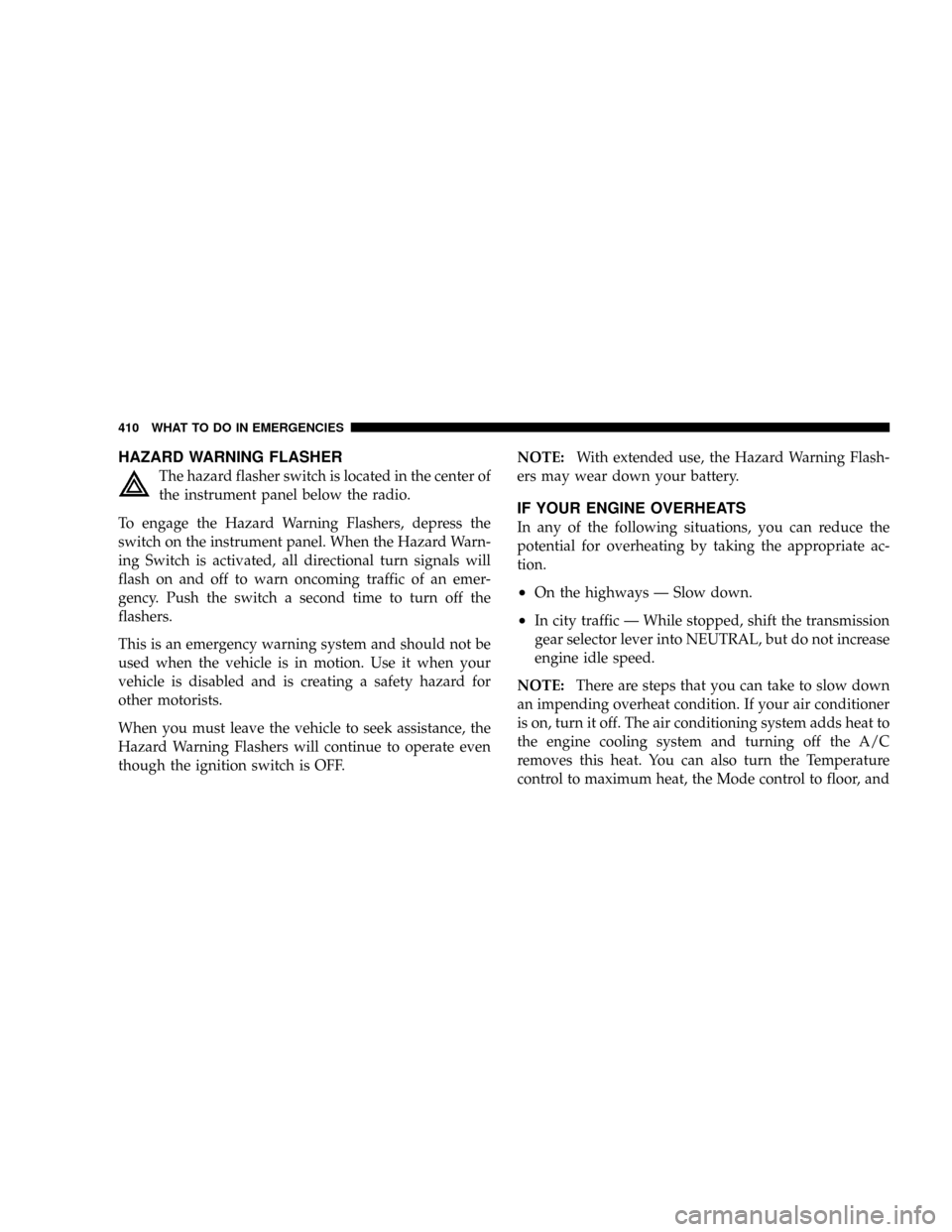
HAZARD WARNING FLASHER
The hazard flasher switch is located in the center of
the instrument panel below the radio.
To engage the Hazard Warning Flashers, depress the
switch on the instrument panel. When the Hazard Warn-
ing Switch is activated, all directional turn signals will
flash on and off to warn oncoming traffic of an emer-
gency. Push the switch a second time to turn off the
flashers.
This is an emergency warning system and should not be
used when the vehicle is in motion. Use it when your
vehicle is disabled and is creating a safety hazard for
other motorists.
When you must leave the vehicle to seek assistance, the
Hazard Warning Flashers will continue to operate even
though the ignition switch is OFF.NOTE:With extended use, the Hazard Warning Flash-
ers may wear down your battery.
IF YOUR ENGINE OVERHEATS
In any of the following situations, you can reduce the
potential for overheating by taking the appropriate ac-
tion.
²On the highways Ð Slow down.
²In city traffic Ð While stopped, shift the transmission
gear selector lever into NEUTRAL, but do not increase
engine idle speed.
NOTE:There are steps that you can take to slow down
an impending overheat condition. If your air conditioner
is on, turn it off. The air conditioning system adds heat to
the engine cooling system and turning off the A/C
removes this heat. You can also turn the Temperature
control to maximum heat, the Mode control to floor, and
410 WHAT TO DO IN EMERGENCIES
Page 413 of 531
the fan control to High. This allows the heater core to act
as a supplement to the radiator and aids in removing heat
from the engine cooling system.
CAUTION!
Driving with a hot cooling system could damage
your vehicle. If temperature gauge reads ªHº, pull
over and stop the vehicle. Idle the vehicle with the air
conditioner turned off until the pointer drops back
into the normal range. If the pointer remains on the
ªHº, turn the engine off immediately, and call for
service.
WARNING!
A hot engine cooling system is dangerous. You or
others could be badly burned by steam or boiling
coolant. You may want to call a service center if your
vehicle overheats. If you decide to look under the
hood yourself, see Section 7, Maintenance, of this
manual. Follow the warnings under the Cooling
System Pressure Cap paragraph.
WHAT TO DO IN EMERGENCIES 411
6
Page 430 of 531
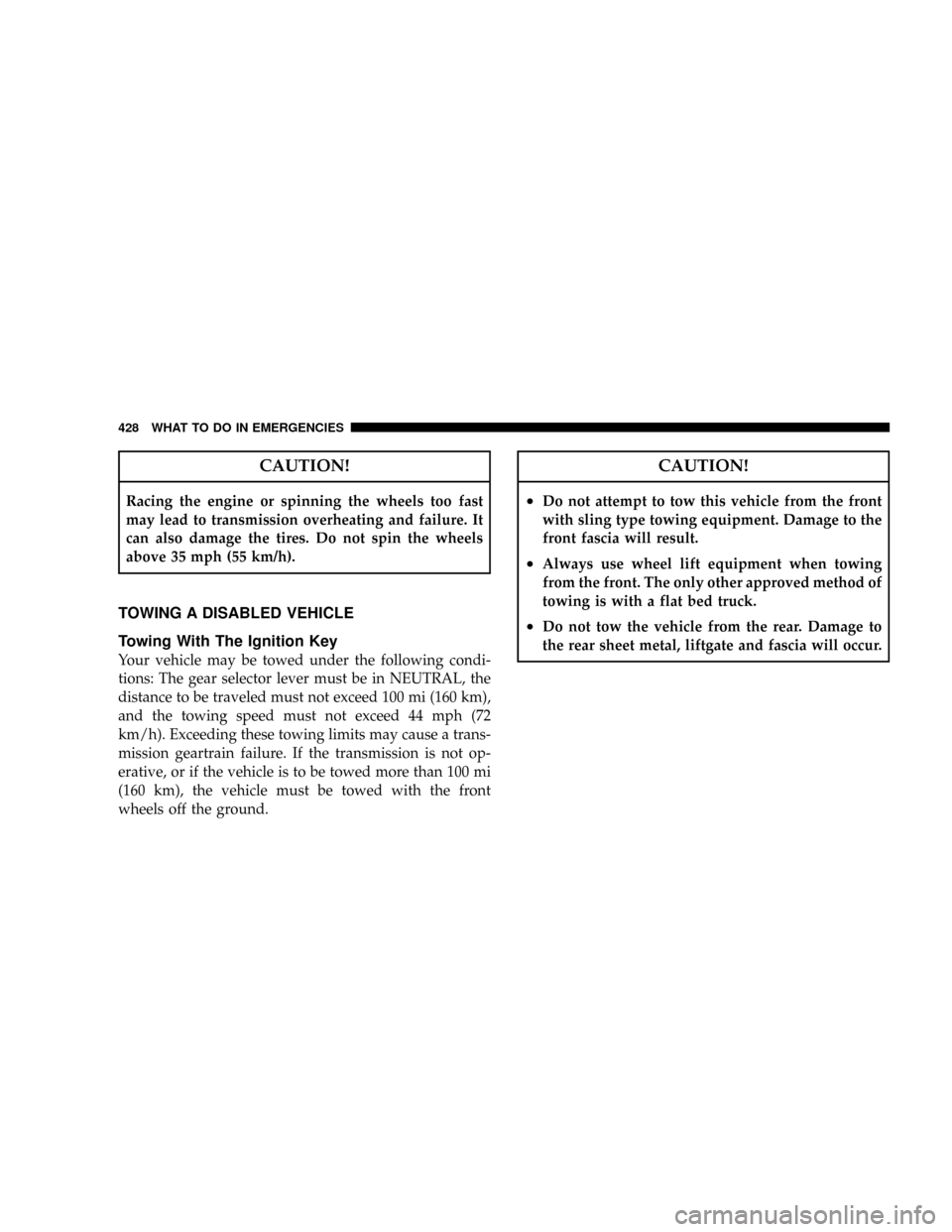
CAUTION!
Racing the engine or spinning the wheels too fast
may lead to transmission overheating and failure. It
can also damage the tires. Do not spin the wheels
above 35 mph (55 km/h).
TOWING A DISABLED VEHICLE
Towing With The Ignition Key
Your vehicle may be towed under the following condi-
tions: The gear selector lever must be in NEUTRAL, the
distance to be traveled must not exceed 100 mi (160 km),
and the towing speed must not exceed 44 mph (72
km/h). Exceeding these towing limits may cause a trans-
mission geartrain failure. If the transmission is not op-
erative, or if the vehicle is to be towed more than 100 mi
(160 km), the vehicle must be towed with the front
wheels off the ground.
CAUTION!
²Do not attempt to tow this vehicle from the front
with sling type towing equipment. Damage to the
front fascia will result.
²Always use wheel lift equipment when towing
from the front. The only other approved method of
towing is with a flat bed truck.
²Do not tow the vehicle from the rear. Damage to
the rear sheet metal, liftgate and fascia will occur.
428 WHAT TO DO IN EMERGENCIES
Page 448 of 531
CATALYTIC CONVERTER
The catalytic converter requires the use of unleaded fuel
only. Leaded gasoline will destroy the effectiveness of the
catalyst as an emission control device.
Under normal operating conditions, the catalytic con-
verter will not require maintenance. However, it is im-
portant to keep the engine properly tuned to assure
proper catalyst operation and prevent possible catalyst
damage.CAUTION!
Damage to the catalytic converter can result if your
vehicle is not kept in proper operating condition. In
the event of engine malfunction, particularly involv-
ing engine misfire or other apparent loss of perfor-
mance, have your vehicle serviced promptly. Contin-
ued operation of your vehicle with a severe
malfunction could cause the converter to overheat,
resulting in possible damage to the converter and the
vehicle.
NOTE:Intentional tampering with emissions control
systems can result in civil penalties being assessed
against you.
446 MAINTAINING YOUR VEHICLE
Page 449 of 531
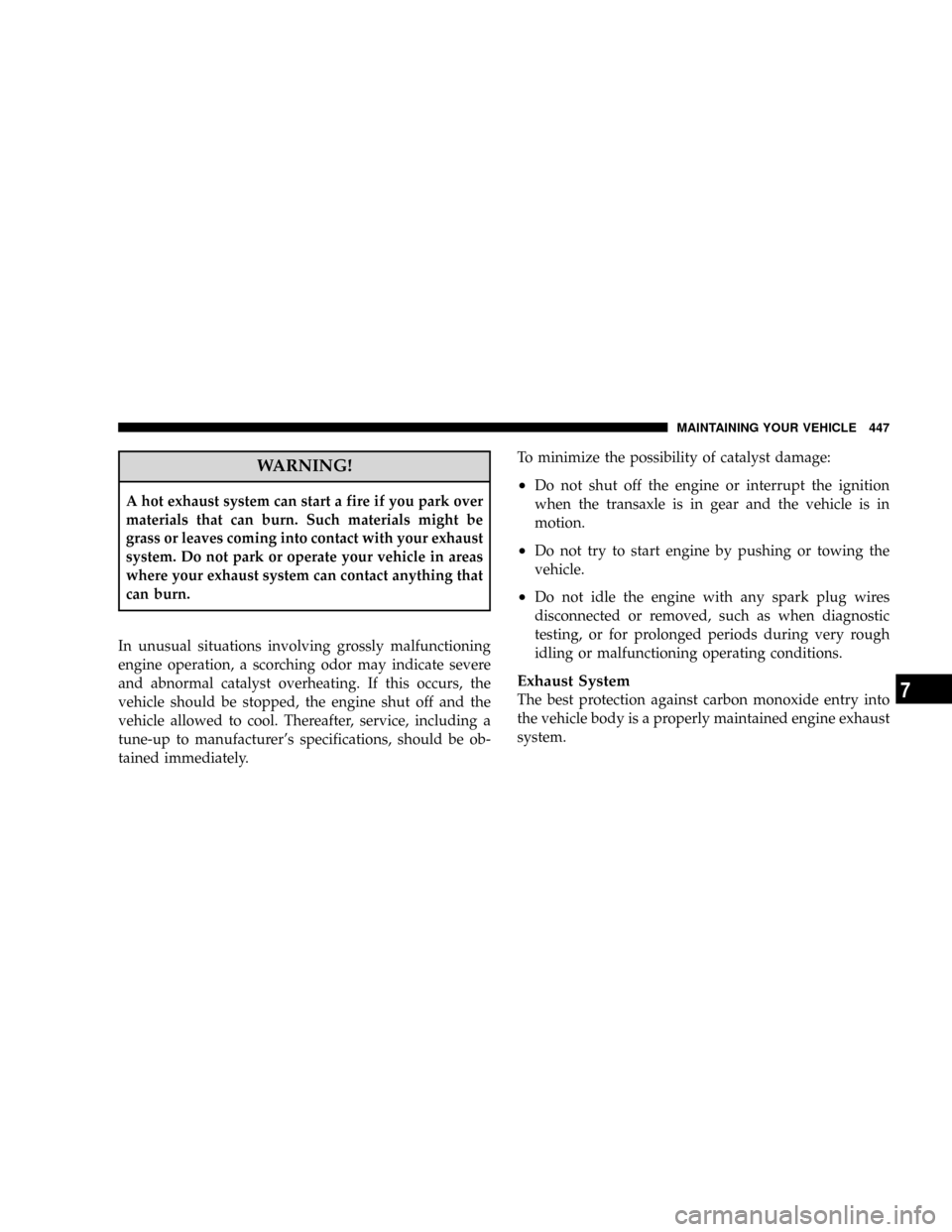
WARNING!
A hot exhaust system can start a fire if you park over
materials that can burn. Such materials might be
grass or leaves coming into contact with your exhaust
system. Do not park or operate your vehicle in areas
where your exhaust system can contact anything that
can burn.
In unusual situations involving grossly malfunctioning
engine operation, a scorching odor may indicate severe
and abnormal catalyst overheating. If this occurs, the
vehicle should be stopped, the engine shut off and the
vehicle allowed to cool. Thereafter, service, including a
tune-up to manufacturer's specifications, should be ob-
tained immediately.To minimize the possibility of catalyst damage:²Do not shut off the engine or interrupt the ignition
when the transaxle is in gear and the vehicle is in
motion.
²Do not try to start engine by pushing or towing the
vehicle.
²Do not idle the engine with any spark plug wires
disconnected or removed, such as when diagnostic
testing, or for prolonged periods during very rough
idling or malfunctioning operating conditions.
Exhaust System
The best protection against carbon monoxide entry into
the vehicle body is a properly maintained engine exhaust
system.
MAINTAINING YOUR VEHICLE 447
7
Page 461 of 531
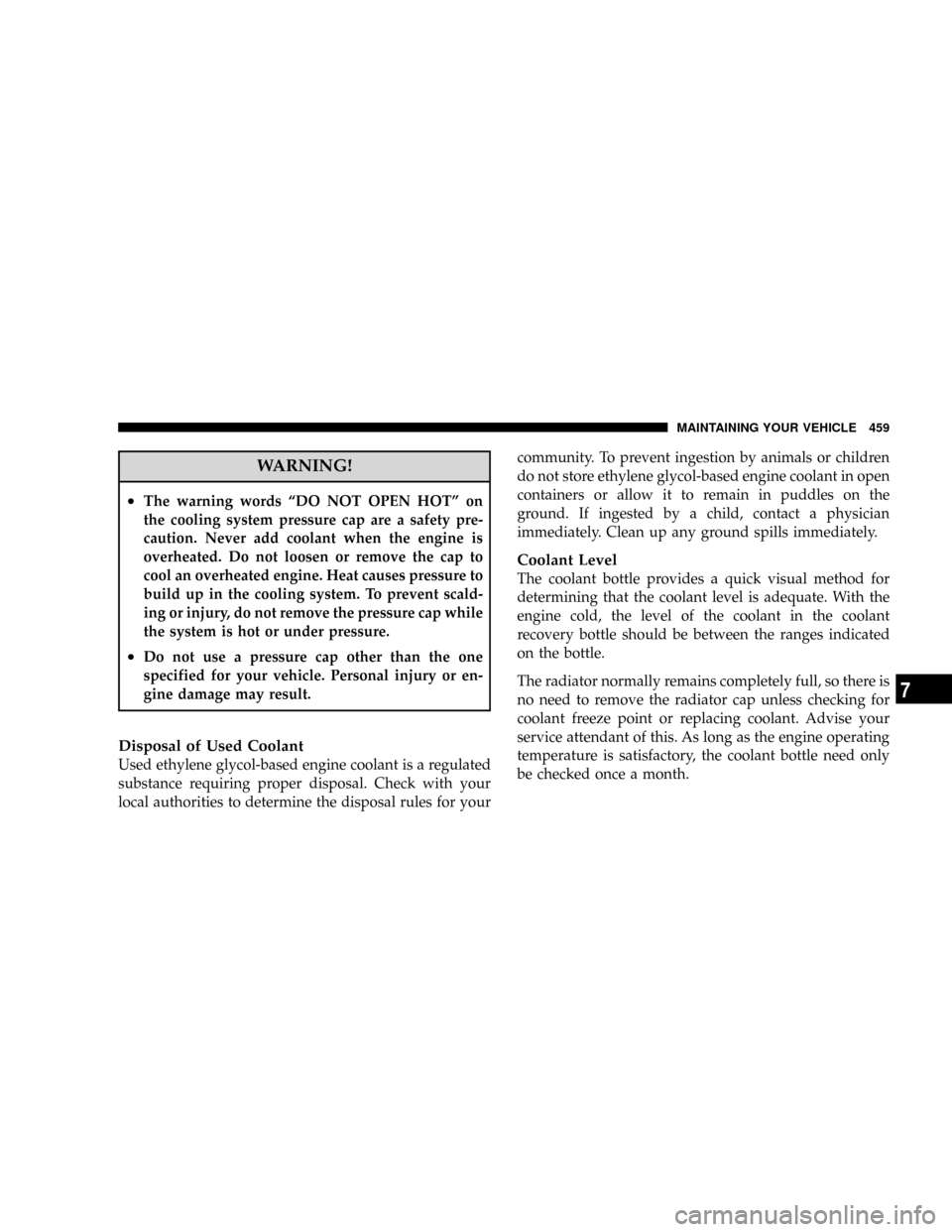
WARNING!
²The warning words ªDO NOT OPEN HOTº on
the cooling system pressure cap are a safety pre-
caution. Never add coolant when the engine is
overheated. Do not loosen or remove the cap to
cool an overheated engine. Heat causes pressure to
build up in the cooling system. To prevent scald-
ing or injury, do not remove the pressure cap while
the system is hot or under pressure.
²Do not use a pressure cap other than the one
specified for your vehicle. Personal injury or en-
gine damage may result.
Disposal of Used Coolant
Used ethylene glycol-based engine coolant is a regulated
substance requiring proper disposal. Check with your
local authorities to determine the disposal rules for yourcommunity. To prevent ingestion by animals or children
do not store ethylene glycol-based engine coolant in open
containers or allow it to remain in puddles on the
ground. If ingested by a child, contact a physician
immediately. Clean up any ground spills immediately.
Coolant Level
The coolant bottle provides a quick visual method for
determining that the coolant level is adequate. With the
engine cold, the level of the coolant in the coolant
recovery bottle should be between the ranges indicated
on the bottle.
The radiator normally remains completely full, so there is
no need to remove the radiator cap unless checking for
coolant freeze point or replacing coolant. Advise your
service attendant of this. As long as the engine operating
temperature is satisfactory, the coolant bottle need only
be checked once a month.
MAINTAINING YOUR VEHICLE 459
7
Page 514 of 531

Digital Video Disc (DVD) Player..........280,283
Dimmer Control........................ 162
Dimmer Switch, Headlight................. 170
Dipsticks
Automatic Transaxle.................... 465
Automatic Transmission................. 466
Oil (Engine).......................... 441
Disabled Vehicle Towing................... 428
Disposal
Antifreeze (Engine Coolant)............... 459
Engine Oil........................... 444
Domelight............................. 161
Door Locks............................. 31
Door Locks, Automatic.................... 34
Door Opener, Garage..................... 185
Drive Belts............................ 445
Drive Shaft Universal Joints................ 454
Driving
On Slippery Surfaces.................... 345Through Flowing, Rising, or Shallow Standing
Water.............................. 346
DVD Player (Video Entertainment System)...... 297
E-85 Fuel............................. 384
Electric Remote Mirrors................102,103
Electrical Power Outlets................... 195
Electronic Brake Control System............. 340
Brake Assist System.................... 341
Electronic Stability Program............... 342
Electronic Range Select (ERS)............... 333
Electronic Speed Control (Cruise Control)...... 179
Electronic Stability Program (ESP)............ 342
Electronic Vehicle Information Center (EVIC).... 241
Emergency, In Case of
Hazard Warning Flasher................. 410
Jacking...........................412,415
Jump Starting......................... 425
Overheating.......................... 410
512 INDEX
Page 515 of 531
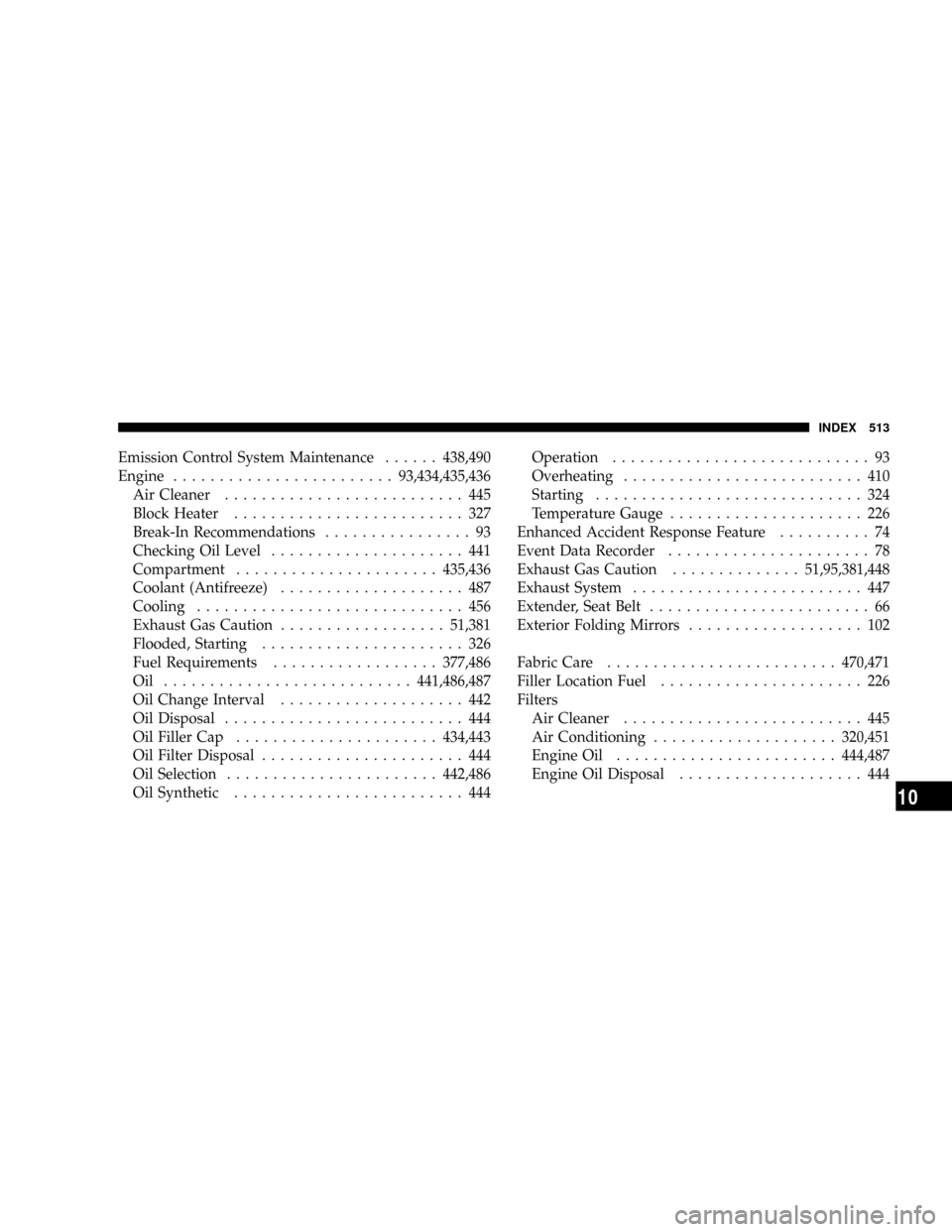
Emission Control System Maintenance......438,490
Engine........................93,434,435,436
Air Cleaner.......................... 445
Block Heater......................... 327
Break-In Recommendations................ 93
Checking Oil Level..................... 441
Compartment......................435,436
Coolant (Antifreeze).................... 487
Cooling............................. 456
Exhaust Gas Caution..................51,381
Flooded, Starting...................... 326
Fuel Requirements..................377,486
Oil ...........................441,486,487
Oil Change Interval.................... 442
Oil Disposal.......................... 444
Oil Filler Cap......................434,443
Oil Filter Disposal...................... 444
Oil Selection.......................442,486
Oil Synthetic......................... 444Operation............................ 93
Overheating.......................... 410
Starting............................. 324
Temperature Gauge..................... 226
Enhanced Accident Response Feature.......... 74
Event Data Recorder...................... 78
Exhaust Gas Caution..............51,95,381,448
Exhaust System......................... 447
Extender, Seat Belt........................ 66
Exterior Folding Mirrors................... 102
Fabric Care.........................470,471
Filler Location Fuel...................... 226
Filters
Air Cleaner.......................... 445
Air Conditioning....................320,451
Engine Oil........................444,487
Engine Oil Disposal.................... 444
INDEX 513
10